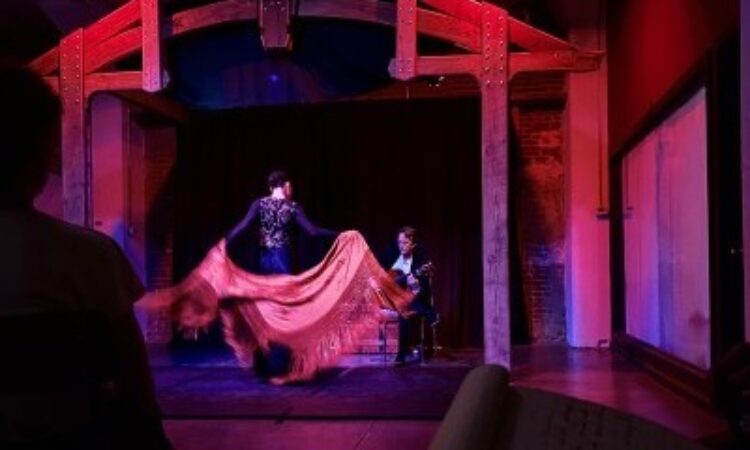I walked into Prism Arts Philadelphia and surprisingly felt a jarring echo of my colonial masters. Raul Mannola played guitar under a colossal wooden structure resembling the architecture of a church. Perhaps this fixture is permanent to the performance space, or perhaps this is part of the experimental collaboration that Raul Mannola and Aylin Bayaz brought to the Philadelphia Fringe Festival with Flamencodanza. As a Filipina whose blood memories are clouded by a dark tint of pain, of grandmothers’ cries in the hands of friars, of romanticized notions of what could have been if my ancestors were left in peace, watching this show from an old, wooden church bench reminded me of colonial Spain.
Mannola masterfully played a collection of Flamenco pieces interspersed with dances by Aylin Bayaz. Bayaz’s dancing was crisp and fiery, weaving together strength and elegance. She performed a contemporary Buleria Por Solea in a long, black, silky dress with lace trimmings, and later, she came back in a red pantsuit and vest to perform what I assumed was the Farruca, a dance often performed by a male dancer. I enjoyed this gender-bending rendition very much.
Throughout the entire show, I only heard Mannola’s voice, almost simulating a lecture demonstration on Contemporary Flamenco music. Bayaz’s beauty and grace were seen, yet her voice was never heard. Connection lacked between the dancer and musician. The embodied and vocal conversations that I recall as inherent in Flamenco were absent. There were no yelps, audible cheers, or sudden outbursts of “Olé.” This may be what Contemporary Flamenco means.
As a movement scholar and dance maker, I am privy to looking critically into the intentions and meanings behind design and performance. Missing the elements of Flamenco roots, I share a quote by Dr. Brenda Gottschild from the article, Decolonizing Flamenco Through Exploring Black Influences. “Frequently, flamenco is described as a melding of Roma, Arab, Jewish and Iberian elements; the Black African imprint is rarely credited….” Thus, I wonder if “Contemporary” definitions are universally the same: defined by a Eurocentricity, removed of story, and void of Africanist identifiers.
Mannola is heavily influenced by Jazz music, citing the African-American jazz artist John Coltrane. I enjoyed Mannola’s exploration of music genres, from Flamenco to Brazilian and American Jazz. However, perhaps he is enjoying these forms for a reason yet to be acknowledged. Since Flamenco is a merging of Roma, African, and Eurocentric modalities while Jazz Dance is rooted in African, Black vernacular, influenced by migratory cultures, and eventually Eurocentric aesthetics, perhaps his fascination for both forms isn’t so much of a fusion, but an archive of their commonalities.
Despite my critique on set, research, and dramaturgy, the artists bring a mastery everyone should witness. Aylin Bayaz and Raul Mannola will bring Flamencodanza to Philadelphia audiences again next weekend, September 15-16 at Sound Space Philadelphia.
Flamencodanza, Aylin Bzyaz with Raul Mannola, Prism Arts Philadelphia, Philly Fringe Festival, Sept. 7-8.






